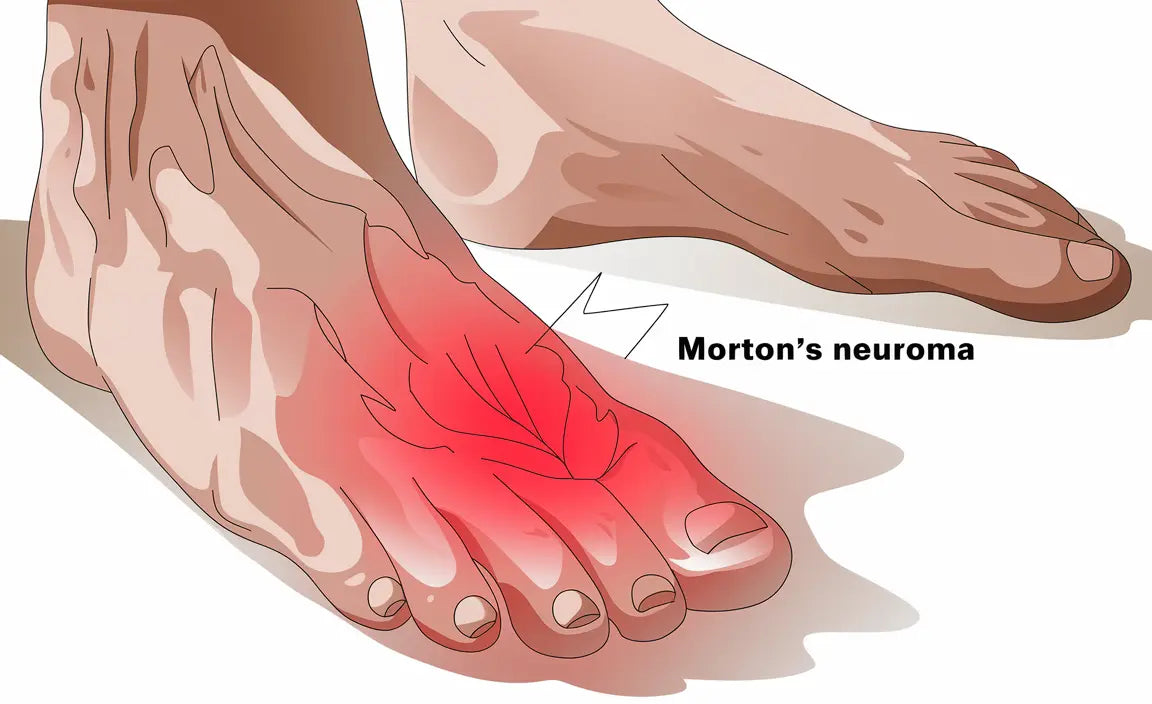Morton's Neuroma: Symptoms, Causes, and Treatment

Morton's neuroma is a painful condition that occurs when a nerve in the forefoot becomes compressed and forms a thickening. This article discusses the most common symptoms, causes, and treatment options for Morton's neuroma.
What is Morton's Neuroma?
Morton's neuroma is a thickening of nerve tissue that typically occurs between the third and fourth toes, causing pain and discomfort in the forefoot. It is a form of entrapment of a sensory nerve that runs between the metatarsal bones in the foot. When the nerve becomes irritated, it can swell and thicken, further increasing pressure on the nerve. This condition occurs more frequently in women and usually affects individuals aged 40-50 years, but it can impact people of all ages. Morton's neuroma is also referred to as Morton's metatarsalgia or interdigital plantar neuroma.
Identify Symptoms and Pain: How is Morton's Neuroma Noticed?
Common symptoms include:
- Pain in the forefoot, often radiating into the toes
- Burning or tingling sensation
- Numbness in the toes
- Increased pain when wearing tight shoes or during activity
The pain associated with Morton's neuroma is typically felt between the third and fourth toes, but can also occur between the second and third toes. Many describe the sensation as walking on a stone or having a wrinkle in their sock. Symptoms often worsen when wearing high-heeled shoes or shoes that are too tight in the forefoot. As the condition worsens, pain and sometimes numbness may persist even after removing the shoes. In many cases, pain in the forefoot increases when walking barefoot on hard surfaces.
Causes of Morton's Neuroma
Several factors can contribute to the development of Morton's neuroma:
- Wearing tight shoes or high-heeled shoes
- Repeated impacts to the forefoot, such as during running
- Collapsed arches
- Anatomical foot abnormalities
The underlying cause of Morton's neuroma is increased pressure on the nerves that run between the metatarsal bones (the heads) in the forefoot. This pressure can occur when the front arch of the foot collapses, causing metatarsal bones to come closer together and pinch nerves. Individuals with flat feet or high arches are particularly susceptible. Activities that involve repeated impacts to the forefoot, such as running on hard surfaces, can also negatively affect and contribute to inflammation and development of neuromas.
Diagnosis and Treatment of Morton's Neuroma
| Behandlingsmetod | Beskrivning | Fördelar med FotSupporten 2.0 |
|---|---|---|
| Konservativ behandling | Ändring av skodon, inlägg med pelott | Ger stöd och avlastning till fotvalvet |
| Övningar och massage | Stärker fotens muskler och minskar smärta | Kompletterar träning för bättre fotfunktion |
| Kortisoninjektion | Kan ge tillfällig smärtlindring | Kan minska behovet av injektioner |
| Operation | Avlägsnar den förtjockade nervvävnaden | Kan potentiellt förebygga behov av kirurgi |

How FotSupporten 2.0 Helps: Convenient Support with Pelott and Comfort Insoles
FotSupporten 2.0 from Komforten offers several benefits for individuals with Morton's neuroma:
- Provides support and relief to the arch of the foot
- Helps distribute pressure evenly across the foot
- Can reduce strain on the affected nerve
- Improves foot position and function
- Serves as an alternative to custom-made insoles with pelott
FotSupporten 2.0 features a front pelott that provides extra support under the forefoot arch. This pelott typically yields good results by lifting the joint heads and creating more space for the nerve's passage between the metatarsal bones. This results in reduced strain and less pressure on the nerve, which in turn can alleviate pain. Unlike many other manufactured pelott insoles, FotSupporten 2.0 can be used in various shoe models and even in some sandals for optimal comfort throughout the day.
Buy nowSummary: Manage Morton's Neuroma with the Right Care and Treatment
Morton's neuroma can be a painful and troublesome condition, but with the right treatment and support, many individuals can effectively manage their symptoms. By combining conservative treatment methods such as changing footwear, exercises, massage, and using supportive insoles like FotSupporten 2.0, significant improvements can often be achieved without the need for surgery. It is important to consult a doctor or foot specialist for an accurate diagnosis and individualized treatment plan.
Frequently Asked Questions (FAQ): Everything About Morton's Neuroma, Treatment, Surgery, and Inserts
Can Morton's neuroma disappear on its own?
How effective is massage for Morton's neuroma?
Massage can help reduce tension in the foot and temporarily relieve pain, but should be combined with other treatment methods for best results.
Is surgery always necessary for Morton's neuroma?
No, many cases can be successfully treated with conservative methods. Surgery is usually considered only when other treatments have not provided sufficient relief.
How long should I use FotSupporten 2.0 to see results?
Many experience immediate relief, but for long-term effects, continuous use is recommended. Consult a foot specialist for personalized recommendations.
Can I continue to train with Morton's neuroma?
Yes, but it is important to adapt the activities and use appropriate shoes and insoles. Low-intensity activities and specific foot exercises can often be performed without any issues.
